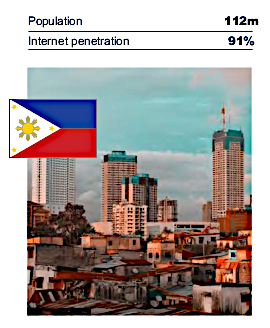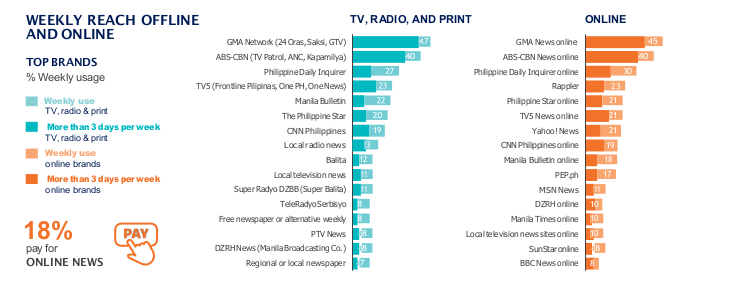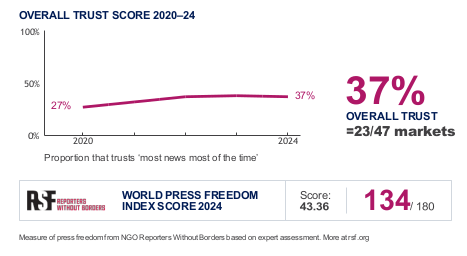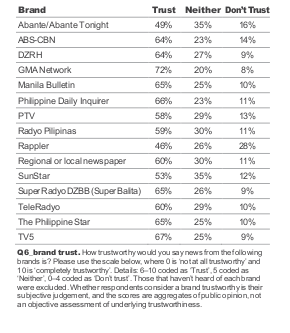
 The Philippine news media landscape has seen significant changes over the past year, especially in private broadcasting, which is experiencing a continuing decline in viewership. Concerns over press freedom persist, highlighted by the United Nations special rapporteur’s alarm over ongoing attacks on journalists and activists.
The Philippine news media landscape has seen significant changes over the past year, especially in private broadcasting, which is experiencing a continuing decline in viewership. Concerns over press freedom persist, highlighted by the United Nations special rapporteur’s alarm over ongoing attacks on journalists and activists.
The ownership and operation of several private broadcasters were caught in a state of flux marked by financial losses and closures, emergence of new partnerships, and government flexing its regulatory powers. In one of the most significant developments, Swara Sug Media Corp, which operates the far-right, religious-run Sonshine Media Network International (SMNI), is at risk of losing its 25-year congressional franchise due to accusations of misinformation, ‘red- tagging’ (labelling individuals or groups as communists or terrorists), and failing to inform Congress of major corporate changes. A House bill seeking to revoke its franchise, due to expire in 2044, awaits Senate approval.
Earlier, the National Telecommunications Commission (NTC) indefinitely suspended SMNI’s operations at the House’s behest, although it remains active on social media.137 SMNI is owned by religious leader Apollo Quiboloy, a friend and ally of former president Rodrigo Duterte whom he engaged to broadcast a weekly show. In December the show was suspended by the Movie and Television Review and Classification Board over alleged death threats and vulgar language, alongside another programme accused of falsely reporting on the Speaker’s travel expenses.
Nine Media Corp’s staggering financial losses led it to shut down CNN Philippines in January. However, a partnership with TV5 Network, owned by business magnate Manuel V. Pangilinan, allowed for the launch of RPTV on the same frequency, expanding Pangilinan’s MediaQuest Holdings, which encompasses TV5, Cignal TV (One PH), BusinessWorld, and The Philippine Star.
When the country’s largest broadcast network, ABS-CBN, failed to get Congress to renew its franchise in 2020, it was forced to take its primetime newscast, TV Patrol, off its long-held free-to-air frequency, Channel 2, but kept running the service on its own cable channel and on A2Z through a partnership with the evangelical church-owned Zoe Broadcasting. TV Patrol in mid-April began simulcasting on its old frequency, thanks to a partnership with business tycoon and former Senate President Manuel Villar’s ALLTV, Advanced Media Broadcasting System, which now occupies ABS-CBN’s old frequency.
Months earlier, ABS-CBN’s TeleRadyo returned to its old AM band as the rebranded TeleRadyo Serbisyo Radyo 630 as the network forged a joint venture with Prime Media Holdings associated with the family of Speaker Martin Romualdez. The partnership has broadened Romualdezes’ footprint in the industry, which includes the Journal Group, Manila Standard, FM Radio Philippines, and the regional television network PRTV.
The leading network, GMA Network, introduced AI sportscasters Marco and Maia in keeping with its ‘commitment to innovation in journalism’. The move sparked discussions on the use of AI in media, including the necessity and limitations of AI-generated presenters in a field packed with energy and emotion. GMA’s former Digital Media head and Nieman fellow Jaemark Tordecilla, meanwhile, created a custom AI assistant that summarises government audit reports to assist investigative reporting.138 Rappler has added AI summarisation features to its website and also unveiled Rappler Communities, a ‘digital town square’ for web and mobile that combines AI and human moderation to create safe spaces to discuss a wide range of subjects, from governance to travel.
During her visit to Manila, UN Special Rapporteur on Freedom of Opinion and Expression, Irene Khan, noted that the government of President Ferdinand Marcos Jr. was ‘more amiable’ toward the media than the previous Duterte administration, but expressed concerns over the red-tagging of journalists, misuse of libel laws against the media, a state order blocking the websites of alternative media platforms Bulatlat and Pinoy Weekly, failure to renew ABS- CBN’s franchise, and the inadequacy of a governmental task force in protecting journalists.139
As of January, the National Union of Journalists of the Philippines documented 109 incidents of attacks and threats against journalists during the Marcos presidency, 47% higher over the same period than during Duterte’s time. Rappler cofounder and Nobel Peace Laureate Maria Ressa’s appeal of her cyber libel conviction remains pending before the Supreme Court, to which Khan has been admitted as an amicus curiae.
Philippine journalists, however, received a piece of good news days after World Press Freedom Day when a court convicted the gunman in the 2022 killing of broadcaster Percy Lapid. The mastermind, a former prisons chief, remains at large. The media, meanwhile, have stepped up self-policing efforts, setting up nine media-citizen councils under the aegis of the Philippines Press Institute (PPI).


CHANGING MEDIA
Online and social media remain the most popular sources of news in the Philippines with our more urban sample. TV and radio news is important for those who are not online, but reach has declined over the last five years.


TRUST
Overall trust in news has remained stable since 2022. Many of the longest established media brands such as GMA Network and the Philippine Daily Inquirer have relatively high levels of trust, but some independent outlets respected for their reporting on those in positions of power are often actively distrusted by supporters of the politicians in question and subject to coordinated harassment. As always, public trust is not in itself a measure of the quality or trustworthiness of the content.


PUBLIC OPINION ON BRAND TRUST
Only the brands listed were included in the survey. It should not be treated as a list of the most or least trusted brands, as it is not exhaustive.




137 Last year’s survey showed SMNI’s online arm as a source of news for 12% of Filipino respondents. The network was not included in this year’s survey.
138 https://reutersinstitute.politics.ox.ac.uk/news/i-created-ai-tool-help-investigative-journalists-find-stories-audit-reports-heres-how-i-did-it
139 https://www.ohchr.org/sites/default/files/documents/issues/expression/statements/20240202-eom-philipines-sr-freedex.pdf


